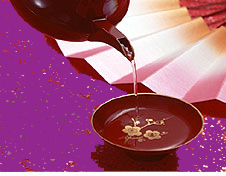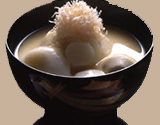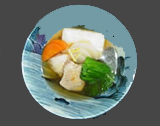Post written by Kumi, United Planet team member

My childhood memories of the end of a year are always associated with preparing Osechi with my mother. She would spend day after day in the kitchen preparing the dishes for about a week leading up to the New Year’s. For as long as I can remember, I would pretend to be cleaning pots and pans for my mother in order to get some goodies like an edge of Datemaki or a chunk of Kinton.
Osech is a generic term for the dishes we eat during New Year’s holiday. The custom of Osech is believed to start during Heian Period, when the time of court culture was flourishing, popularized in literature by female court writers such The Tale of Genji.
In Japanese belief, gods and spirits (based on Shinto/animism) are received in one’s home on New Year’s Day and Osech is the first meal to share with them. All dishes should be an offering with our wishes for health, success, etc. Everything about Osechi has meaning.
There are many basic dishes that are traditionally displayed during Japanese New Year. In order to understand this, you need to know a Japanese language system called Goroawase (Japanese wordplay- a pun). Japanese words can be read to have several different meanings and pronunciations. Often replacing one spelling with other synonyms can give a new meaning to phrases.

1. Datemaki-Rolled sweet Omelet. The shape looks like a a scroll book (emakimono) and ancient Japanese valued books. The wish: to gain a lot of knowledge or to be wise.
2. Kazunoko or Ikura-eggs of herring (kazunoko) or eggs of salmon (ikura) are symbols of prosperity.
3. Kamaboko-Steamed or boiled fish paste (taste is similar to fish ball). Cut one half inch thick and display red (pink) and white alternatively. The combination of white and red is auspicious
4. Konbu -means joy in Goroawase.
5. Fish – King prawn: as the whisker is reminiscent of a wise person, the prawn is a sign of longevity. Bonito- This fish changes names as it grows and is therefore called the fish of promotion, just as an employee receives a new title with each promotion.
6. Tazukuri-small fish in sweet soy sauce. In Ancient times, small fish were used as an organic for rice and vegetable crop fertilizer. This osech is a symbol for good harvest.
7. Kuromame-kur o(black)Mame (beans) in syrup. Mame in goroawase means hard work. The color black is believed to have a special power to spare evil spirits.
There are too many dishes to list and they vary widely by region and family. I am from the Northeast of Japan, so these dishes may be different in other regions.
Cooking is only part of the story. All dishes should be displayed in three to five layers of Jubako (similar to bento boxes served in Japanese restaurants). Odd numbers of layers are used, because when you divide even numbers, the number continues forever. When five layers are used, the top layer is left empty to symbolize the individual’s room for growth in the coming year.
Now things are becoming more complicated. All dishes have their own specific place to be displayed. I remember my mother would call her mother to confirm. When you get married in Japan, the first year is very tricky. You will follow your husband’s family tradition. A long talk with your mother-in-law about the family custom and tradition is necessary.

We go to the shrine or temple after we eat tosikosi soba noodle (soba is physically long and represents longevity) just before midnight on New Year’s Eve. We make a wish and pick a fortune-telling card. Don’t be sad if you see “Dai Kyo” (great curse) on the surface. Don’t forget to pick an orange and Omiki, which is sake to offer to Gods and spirits. You will share sake with them. The explanation you see inside is more important than the status! The next morning, New Year’s Day, we eat the dishes with otoso (herbal sake for good health) and ozoni (mocha and other ingredients in soup) to wish for a good harvest. Don’t forget to offer these dishes to the home shrine before you eat. We do not want to disturb any gods and spirits!
These dishes are meant to last long so that we will be able to eat them for a few days during the New Year holiday. We are not supposed to use the kitchen while gods and spirits are still there. If you do, you may disturb the Fire God and this is not good at all. Your house may catch fire. Also ladies do not have to cook during the holiday. We serve the dishes to the family and guests.
I hope you have a lot of good wishes for 2009 and all wishes come true!
ABOUT UNITED PLANET
United Planet is a non-profit organization with a mission to create a global community, one relationship at a time. Established in 2001, United Planet offers volunteer abroad, virtual internships, internships abroad, gap year volunteering, and global virtual exchange in more than 40 countries.




